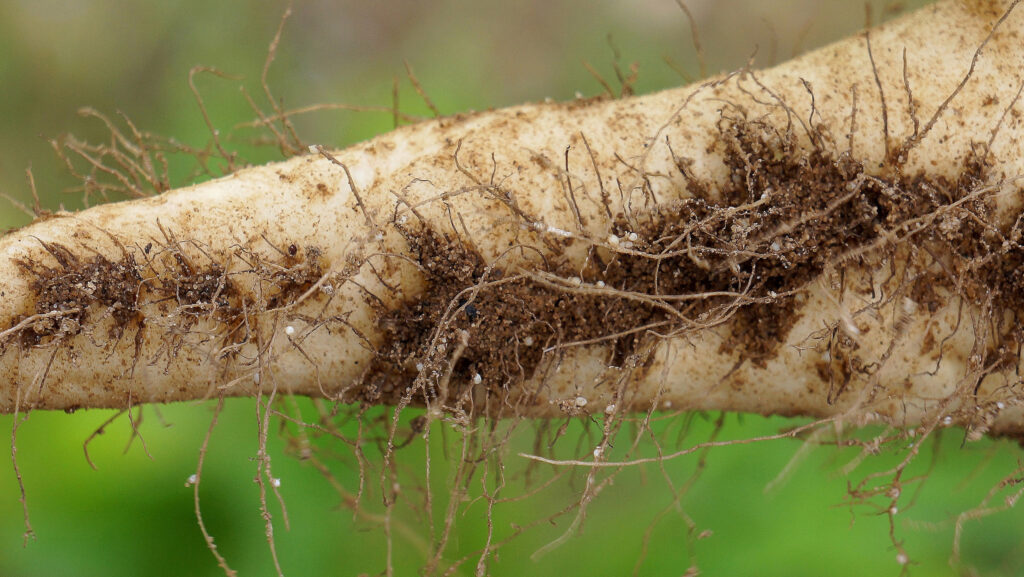How soil testing can tackle sugar beet cyst nematode
 © Blackthorn Arable
© Blackthorn Arable Beet cyst nematode is an increasing threat to British sugar beet crops and growers are urged to ramp up soil testing efforts to identify problems and steer management around crop rotations.
Speaking at the recent Association of Independent Crop Consultants (AICC) conference, British Beet Research Organisation crop protection scientist Dr Alistair Wright said distribution of the pest is underestimated.
The most recent survey work confirmed beet cyst nematode (BCN) is present in all four factory areas and historical assumptions were that 6-10% of land was infested.
See also: Project aims to tackle emerging sugar beet disease
What is beet cyst nematode?
The beet cyst nematode, Heterodera schachtii, is a microscopic worm which feeds from the fibrous roots of sugar beet and other hosts.
The nematodes are soil-borne and can persist in infected fields for a long time, sometimes well over 10 years.
Eggs which contain the infective juvenile nematodes remain dormant inside a protective cyst for many years, waiting for the right conditions in which to hatch.
The juveniles invade the roots and start feeding from the plants.
Alistair thinks it is now more likely 25-30%, which is very concerning for the industry, as the nematode can cause up to 60% yield loss in worst cases.
“There’s a lot more out there than growers take for granted, and the reason it’s more widespread is because field hygiene is generally not good enough,” he added.
Persistent pest
BCN cysts, which contain the juveniles that hatch out and invade roots of host plants to continue the pest’s life cycle, can persist in the soil for a decade, making it incredibly hard to eradicate.
It is also spread via wind, water, wildlife and livestock movement, but machines such as harvesters are the number one enemy for moving through large areas with no cleaning.
Another key factor increasing BCN risk is warmer soils in the spring, caused by climate change, allowing the pest to complete an extra generation or two a season.
Cover crops and Sustainable Farming Incentive options are contributing too, by helping the pest proliferate with common constituents such as oil radish, tillage radish, white mustard, vetch and buckwheat being BCN hosts.
Without careful management of sowing date and destruction, all these species facilitate significant multiplication in the soil and increase risk of yield loss in sugar beet crops.
Soil sampling
At about £100/sample, BCN testing is costly, due to the specialist equipment and rare expertise required by labs to speciate the pest. But, it is money well spent, according to Alistair.
“Get out there with a soil corer and bucket – it could really help you avoid those massive yield losses,” he urged.
Testing results will inform effective targeting of tolerant varieties, which help avoid significant multiplication, and are by far the most straightforward management tool for BCN.
Furthermore, knowing where populations are located will help growers avoid planting susceptible cover crops that could potentially host the pest and increase numbers ahead of future beet crops.
Although biofumigation is used against other cyst nematodes, such as potato cyst nematode (PCN), Alistair cautioned that the brassica species used for PCN biofumigation are hosts to BCN, so it might not have a role in sugar beet.
Instead, he sees trap crops of resistant radish and mustard varieties as more useful, achieving 40-50% reductions when managed well, but results can vary significantly between years.
“Use class 1 varieties if you can, which are the most resistant. Class 2 varieties are OK if you have a low level of fields, or where you don’t think there’s any BCN, but it’s a high-risk soil type,” Alistair said.
Field hygiene
Norfolk AICC agronomist Penny Oakes added that soil testing is already an important management tool and stressed the importance of tightening up field hygiene too.
This involves cleaning farmer and contractor machinery as it leaves fields, particularly where testing has identified a population and there is a risk of transferring cysts to clean land.
Beet spoil around cleaner/loaders is another area of concern and where possible, it should be returned to the field of origin to isolate any BCN issues.
“Monitoring crops for symptoms is a good habit to get into, with summer the best time to pull up roots and look for the white cysts on roots.
“It’s important to make detailed records of where problems are as well, as alongside soil sampling and testing, it will help accurately guide future management of BCN.”
Beet cyst nematode management – key points
- BCN is widespread and underestimated across the British sugar beet area
- A warmer climate and certain cover crops are exacerbating the problem
- Regular soil testing is essential for detecting BCN and informing strategies
- Tolerant varieties and trap crops are useful in reducing multiplication
- Good field hygiene and record-keeping habits key to long-term control.

